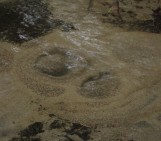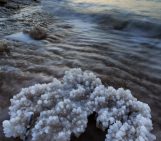This week’s photo is a beautiful example of geochemistry in action. Briefly, travertine, which is composed of CaCO3 is often precipitated at hot springs as they emerge from the ground forming these gorgeous terraces. The reason for their formation is Henry’s gas law in action which states “the solubility of a gas in a liquid is directly proportional to the partial pressure of the gas above the liquid” which in this case is the open air. At depth, the superheated water contains lots of dissolved carbon dioxide, which lowers the water pH and allows it to dissolve carbonate minerals it comes in contact with. However, once the water reaches the surface the CO2 degasses because of the much lower partial pressure (concentration) of CO2 in the atmosphere à la Henry’s law. This causes the pH to rise which in turn leads to precipitation of dissolved carbonates such as aragonite and calcite (travertine).
By the way, I have always, always wanted to swim/lounge in one of these sorts of places but have never had the chance. Maybe one day!

Mammoth Hot Springs – travertine terrace – Credit: Joern Behrens (distributed via imaggeo.egu.eu)




Michael Jacobs
Well….while Mammoth Hot Springs is an awesome place to visit…and for minerals geologists a very nice primer to how epithermal hot springs systems work, this is not the place to experience your fist hot springs dip. At 161F (72C) this would be a most unpleasant and most likely fatal dip. There is a hot spring close by on the road up to Mammoth called the Boiling River hot spring where the hot water at about 130F is diluted by colder Gardner River water and you can swim in it. There is also a small resort at Chico Hot Springs along the road in the Paradise Valley between Livingston and Gardner.
I have enjoyed soaking in hot springs in Texas, New Mexico and Nevada. I had one interesting experience with a particular hot spring in Warm Springs, Nevada. I had been mapping and working on a claim block near there as well as other mountains in the area and there is a public hot springs there where I used to stop by and both relax and wash some of the days dirt and sweat off before I would go back to camp. I had a gamma ray scintillometer that I used for field screening outcrops for exploration purposes. Normally this was behind by truck seat and in the off position but this day I had left it on. I was pulling up to the springs to take a quick soak and when I got about 20 yards from the springs my scintillometer started going crazy. So…..I had been soaking in somewhat elevated radioactive spring waters all summer long……sweet!!!!